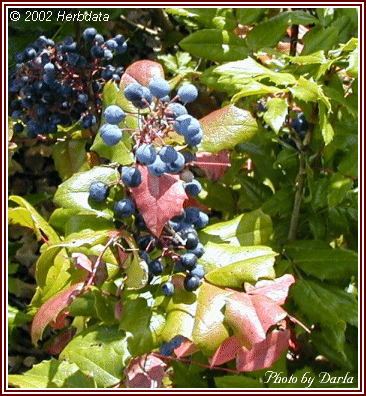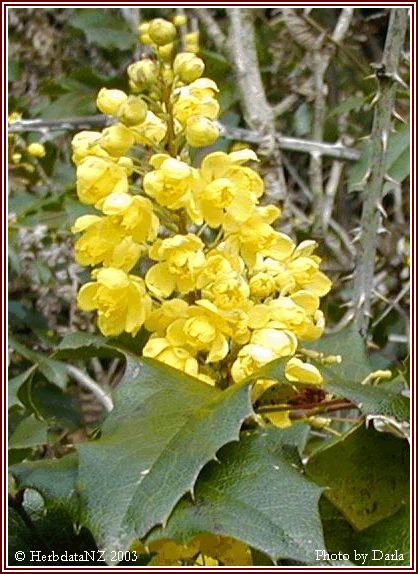
 Berberis Aquifolium
Berberis Aquifolium
U.S.D. 1926. N.F.
Compiled by Ivor Hughes.
BERBERIS. N.F., Br. BERBERIS Berber [Oregon Grape Root]
"Berberis consists of the dried rhizome and roots of species of the section Mahonia (Nuttall) De Candolle of the genus Berberis Linne (Fam. Berberidaceae). Berberis contains not more than 5 per cent, of the over ground parts of the plant or other foreign organic matter. Reject pieces of the rhizome or root over 45 mm. in diameter or with the bark removed." N.F.
Oregon grape root; Nepaul Barberry; Barberry; Epinevinette, Vinettier, Ecorce de Racine de Berb�rides, Fr.; Fauerach, Gemeiner Sauerdorn, Berberitze, Berberitzen(Saurach-) Wurzelrinde, G.; Berbero, It., Sp.
The genus Berberis (Fam. Berberidaceae) is a large one, comprising shrubs or trees which are widely distributed throughout temperate regions and in the mountains of the tropics. There are three well-defined medicinal groups:
(1) The Rocky Mountain group, including Berberis Aquifolium, which
yields the Oregon Grape Root.
(2) The Asiatic group, which includes B. aristata DC., a shrub
indigenous to India and Ceylon, and is recognized by the British
Pharmacopoeia.
(3) The European group, which includes the common Barberry (B.
vulgaris L.), which is naturalized in New England. According to Dragendorff
(Die Heilpflanzen), about forty different species of berberis have been used
in medicine.
Lycium, of the ancients, highly valued as a local application in affections of the eye and eyelids, and used for various other purposes, is supposed to be the medicine still used in India for the same affections, under the name of rusot or ruswut, which is an extract from various species of berberis combined with opium.
Berberis aristata, which furnishes the berberis of the British Pharmacopoeia, is a shrub indigenous to the temperate Himalayas, extending from Bhutan to Kanawar, the Nilgiri Hills, and Ceylon. It is erect and branching, the leaves being evergreen, obovate or oblong, entire, sometimes possessing spinose teeth. The flowers are yellow and occur in compound, often corymbose racemes. The stigmas are distinguished by being small and subglobose. The berries are few-seeded and taper into a short style. Several varieties of this species are recognized, viz., floribunda and micrantha. The type B. aristata closely resembles B. asiatica Roxb., B. Lycium Royle and B. vulgaris L., and consequently are mistaken throughout India. The same vernacular names are frequently applied to each of these plants and the same medicinal properties attributed to all.
The N.F. IV recognizes, under the title Berberis, " the rhizome and roots of species of the section Mahonia Nuttall of the genus Berberis." This section corresponds to the genus Odostemon of Rafinesque, and includes B. Aquifolium .and B. Nervosa. Berberis Aquifolium Pursh., Berberis, U. S. VIII, Oregon Grape Boot, Rocky Mountain Grape, California Barberry, Holly-leaf Barberry, Trailing Mahonia.
The Oregon grape is a tall shrub, about six to seven feet high, with evergreen, coriaceous, bright and shining leaves, and having numerous small, yellowish-green flowers in the early Spring, and later clusters of purple berries containing an acid pulp. It is a native in woods from Colorado to the Pacific Ocean, especially abundant in Oregon and northern California. Rusby believes that a large part of the berberis collected in Oregon is obtained from B. Nervosa. (Ph. Era, 1909, p. 633.) Nepaul Barberry (Berberis vulgaris L.) is a native of Europe, but grows wild in waste ground in the eastern parts of New England, and is sometimes cultivated in gardens on account of its berries. It is a spreading shrub, from four to six feet or more in height, with thorny branches, a light gray bark and a fine yellow wood.
The berries of B. vulgaris, which grow in loose bunches, are oblong and of a red color, have a grateful, sour, astringent taste, and contain malic and citric acids. They are refrigerant, astringent and antiscorbutic, and are used in Europe, in the form of drink, in febrile diseases and diarrheas. An agreeable syrup is prepared from the juice, and the berries are sometimes preserved for the table. The bark of the root of B. vulgaris L. was formerly included in the secondary list of the U. S. Pharmacopoeia, under the name of Berberis. The root and inner bark have been used for dyeing yellow. The bark of the root is grayish on the outside, yellow within, very bitter, and stains the saliva when chewed.
Algerita Root, which has been used by Mexicans and old settlers in Western Texas, is derived from Berberis trifoliatus Moric [Odostemon trifoliatus (Moric.) Heller]. The shrub grows in Western Texas and New Mexico and extends into Mexico. The root contains, according to Hart (A. J. P., 1916, p. 301), 1.3 per cent, of berberine and 0.1 per cent, of associated alkaloids. Hydrastine is absent. Infusions of algerita root are used for eye sores, while chewing the roots is considered reliable as a corrective for sore mouths. Injections of an infusion have been used for gonorrhea. The commercial supplies of berberis used in the United States are obtained from Trieste and Oregon. For a description of the bark of B. aristata DC., by Hartwick, see Ph. Rev., 1896, 232.
Description and Physical Properties.
Unground Berberis. Cylindrical, more or less knotty,
strongly branched, usually cut into pieces of varying length and up to 45
mm. in diameter; usually splitting somewhat on drying; externally light
yellowish brown, longitudinally wrinkled and short scaly; fracture hard and
tough; bark 1 mm. in thickness, easily separable into layers; wood yellow,
the color more pronounced upon wetting, distinctly radiate, and showing
rings of growth; pith of rhizome small, sometimes excentric. Odor slight;
taste distinctive, very bitter; on chewing it tinges the saliva yellow.
Powdered Berberis. Yellowish-brown; composed chiefly of fragments of medullary rays, and wood fibers associated with a few tracheae; wood fibers yellowish, with large, simple, transverse pores; trachea chiefly with bordered pores, occasionally reticulate; starch grains simple or 2 to 3 compound, the individual grains being irregularly spherical, 0.003 to 0.020 mm. in diameter, or occasionally larger. N.F.
The berberis of the British Pharmacopoeia occurs in undulating pieces from two and a half to five centimeters in diameter. Cork orange-brown, removed in places showing the subjacent darker brown cortex; marked with slightly wavy longitudinal striae and occasional shallow transverse depressions. Transverse section shows a narrow brown cork; a broad, dark brown bast traversed by conspicuous yellow medullary rays; a bright yellow wood composed of numerous narrow vascular rays, containing many vessels, separated by narrow, paler medullary rays. Slight odor; taste bitter. Br.
Constituents. Both, the B. vulgaris and B. aquifolium contain three alkaloids of which the most important is berberine, C20H17O4N. This alkaloid is found in numerous other plants of several natural orders, including Hydrastis, Argemone, Coptis, Xanthoxylum, etc. It occurs as golden-yellow crystalline needles, differing from most other alkaloidal bases in being soluble in water, yielding yellow solutions. It is also soluble in chloroform or benzol, but almost insoluble in ether or petroleum benzin. Besides berberine Hesse (B. Chem. G., 1886, xix, 3190) found berbamine, C19H21O3N, and oxyacanthine, C19H21O3N. For general properties and color reactions of these alkaloids see Rudel (J. Chem. S., 1892, p. 641) and Pommerehne (A. Pharm., 1895, ccxxxiii, p. 127).
Uses. The various species of berberis appear to have similar medical properties. The alkaloid berberine is physiologically very feeble. (See Hydrastis.) Antiperiodic properties have been attributed to it, and T. Lascarato (La Grece medicale, 1899, No. 2) affirms that it has a specific action upon the spleen which renders it very valuable in the treatment of malarial splenic enlargement, and that it is so powerful in producing contraction that when the spleen is softened large doses may produce splenic rupture, with fatal hemorrhage. The crude drug probably has no real medicinal effect, except that of a bitter tonic and mild laxative. It is by some believed to have an especial tendency towards the liver and hence is used in jaundice and chronic hepatitis. It is also stated to have alterative powers and has been employed in syphilis and scrofula.
Dose, from fifteen
to thirty grains (1 - 2 Gm.).
Off. Prep. Tinctura Berberidis, Br., Fluid-extractum
Berberidis, N.F.

See also; Fluidextractum
Berberidis, N.F.
If you did not find what you were seeking, use the site search box at the
top right hand of the page or else peruse the site library
![]()